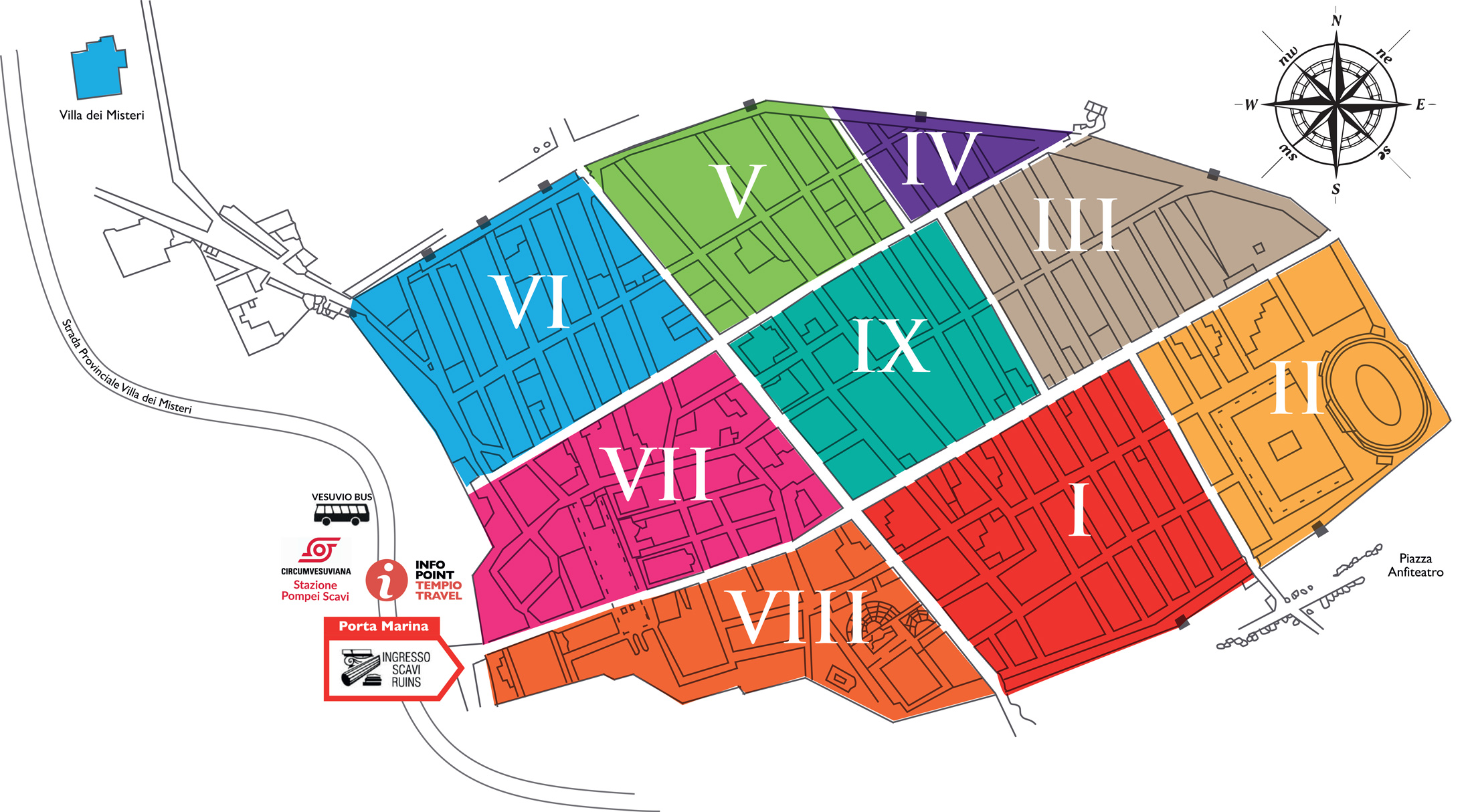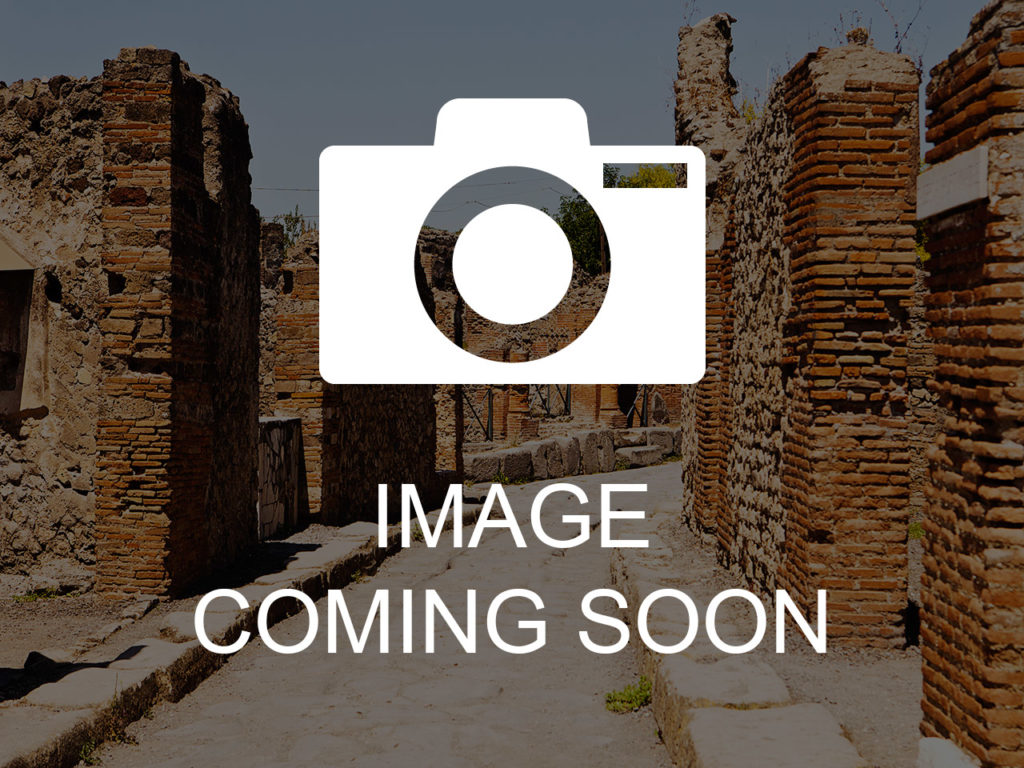Map

REGIO VII
REGIO I
REGIO II
REGIO III
REGIO IV
REGIO V
REGIO VI
REGIO VIII
REGIO IX
REGIO IX
House of M. Epidius Rufus
The House of Sulpicius Rufus islocated on an unnamedstreetthatleads off the south side of the Via di Nola. The housewas first excavated in 1880 and again in 1887 and namedafter a sealfound in the housebearing the name C. Sulpicius Rufus. The houseisalsosometimescalled“House of the Piglet”after the painting of a pig’s head wasfound on the northwall of the kitchen.The faucesopens off the east side of the unnamedstreetand ithaslostmost of itsoriginalplasterwork; a small latrine and twocubicula open off the north side of the fauces. AlsoThese rooms haveremnants of originalplasterwork. The faucesopensdirectlyonto a small peristyle with a central garden surrounded by a lowwall.On thenorthwallthereis a paintedlarariumthatshows twolares on either side of an altar whichhas a serpentwound round it.Next to the lararium, above the end of the hearth, is an unusualrepresentation of food ready to be cookedincludinghangingsausages, a pig’s head, an eel and portions of meat on a spit
House of Marcus Lucretius
Thishousewasknownas the “House of femalemusicians”from a fresco found in the fauces, but the namewaschangedafter the discovery of a painting, found in a room on the north side of the garden, in whichtherewaswrittenthe name of Marcus Lucretius. The building was first excavatedin 1846-1847.The househadoriginally a standard atrium/garden plan, thenitwaschangedbecause a secondpropertywasincludedas a service wing.The rooms of thishouse are decorated with amazingfrescoespaintingsdecoration in fourth style, thatrepresentmanymythologicalsceneslike for example the centralpanels of one of the twovaultedcubicula,thatcontained on the northwall a scene of a Satyr and a Maenad, on the west wallNarcissus with a Cupid (now in the National Museum in Naples) and on the eastwall a muchfaded scene depicting Venus with Cupids.
House of the Pygmies
The housewas first excavated in 1877 and has a standard atrium/garden plan. The building isnotreallywellpreserved and the rooms are decorated with simplepaintings, butthereis a particularkind of fresco painting decoration in one room reproducingpygmies in a Niloticlandscape, realizedduringsecondhalf of the 1st centuryAD, and thatgives the name to the house. In this painting there are some pygmiesalong the banks ofNileriver, wherethere are alsoducks, lotusplants, small islands, and then a dark pygmy with a large phalluscarriestwo large baskets, near a small temple and on a pillar the statue of Sobek, the crocodilegod.Itrapresents the strong connection betwenn Pompeii and Egypt.
House of M. Obellius Firmusì
Thishouselies on the southern side of the Via of Nola, and was first excavated in 1910. Itwasalsoknownas the House of the Count of Turin, and itisone of the biggesthouse of Pompeii; ithastwoatrium and twoperistylegardens. The housewasprobablybuiltduring the samniteperiod for a richlocal family.We can suppose thatthiswas the house of ObelliusFirmusthatwas an importantpolitician of the city (the tomb of the owner can be found just outside the Nola Gate). The househastwomainentrances, and there are othertwoadditionalentrances. The grander of the entrancesopensonto a tetrastyleatrium with a centralimpluvium and has a wonderfullmarblefurnishingsthatunderlined the wealth of the owner; while the secondaryentranceopensonto a Tuscan style atrium.At the rear of the houseis an irregularthreesided portico with a large garden beyond.
House of C. Julius Polybius
The houseissituated on the north side of the street of the Abundance and hastwoentrances, leading to two separate vestibuleswhich, in turn, giveaccess to twodistinctparts of the house. The housedates from the 2nd century BC. The building wasexcavated in 1913 and thenbetween 1966 and 1978. The owner of thishousewas C. IuliusPolybius. The househas an early style paintedfacade with talldoors, and manyamphorasand heaps of limehavebeenfound inside the builiding, demonstratingthat the housewas in restorationat the moment of the eruption. The entirehouseseems to havebeen in a state of flux in the yearsafter the earthquake of AD62 and the tricliniumreflectsthis with the condition of itsdecoration and the mixture of finds in the room.The west side of the house, off vestibule, probablycontained the servantsquarters. Itonlyhas a few rooms on the groundfloorbutdoeshaveaccess to the upperstorey. Unlike the east side, however, itdoesnothavedirectaccess to the peristyleat the rear of the property.
House of the Chaste Lovers
The House of the Chaste Lovers is on the north side of the street of the Abundanceanditwasexcavatedin 1987. The excavation of this building is part of a muchlargerexcavationencompassingmuch of the southern end of Reg IX, Insula 12 including the adjoining House of the Paintersat Work to the north.The housederivesitsname from a fresco in the triclinium of a coupleat a feast in the act of some rathershykissing. The propertywas of mixed use, consisting of a bakery and itsattachedresidentialquarters. On the right hand side of the facadeis a portrayal of Priapus, a minor god of fertility and abundance,making off with the caduceus and wingedsandals of Mercury, in essencethieving from the god of thieves.
Central Baths
The Central Baths of Pompeii wherebuiltduring the restoration of the city carried out after the earthquake of AD62.Theyare at the intersection of twoPompeii’smainstreets: via Stabiana and via of Nola, and theyoccupythewhole insula. The layout of this building hadonly a single set of bathing rooms; thismaymeanthatthisthermalbathswere for men only or womenmighthavehadaccess to the bathsatcertain hours. The mainentrancemayhavebeen on the north side. The entrances on the north, south and west sides led to the palestra, butthis area hadnotbeenfullyclearedat the time of the eruption. The thermal rooms are arrangedaccording to the sequence of apodyterium, frigidarium, tepidarium and laconicum, a domedcompartment with fourapses, intended for hot and dry air baths.
Thermopolium of Asellina
This building, consideredlike an old fast food, lies on Via of the Abundance and takesitsname from the girl thatserved inside this shop, thatwascalledAsellina, thatwaswith othergirlsAegle, Maria and Zmyrina. This building wasexcavated on 1911, and werefoundplates, glasses, jugs, terracotta, bronze and glasscups, where the foodsoldwasserved.



